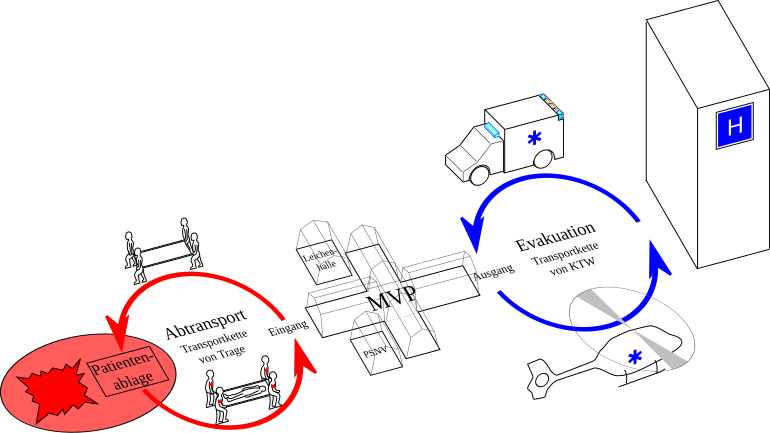Orsec-Novi plan
Plan Orsec-Novi (formerly plan rouge , dt. "Red plan"), short plan Novi ("Orsec" means " organization de sec ours ", dt. "Organization of help", "Novi" "no mbreuses vi ctimes" ", English" mass casualty "), is an emergency plan of the French state in the event of an accumulation of injuries and deaths in a certain region. The aim of the plan is to efficiently coordinate the existing first aid and emergency aid measures and the transport of injured persons. Conceptually, the plan Novi differs from the plan blanc (white plan), which provides measures in the event of a sudden accumulation of hospital patients, and the plan ORSEC , which provides measures in the event of a lack of first aid care . Plan Novi and plan blanc often work at the same time.
The Novi plan is based on four points:
- Sensible organization of the available resources: The various emergency and auxiliary forces (fire brigade, emergency aid, police) should not hinder each other.
- Establishment of two rescue chains: one coordinates the on-site operation, the other the transport of the injured.
- Construction of a field hospital (or an expanded medical base)
- Establishment of two lines: one coordinates the first aid and emergency aid measures on site, the other (mostly at the prefecture ) the further logistics, the reinforcement measures etc.
The plan Novi is the mass casualties comparable in Germany.
history
The Paris fire brigade drafted plan rouge in 1978 after 13 people were killed in an explosion in a fire in downtown Paris. Since 1986, the plan has been in effect for the entire French territory. Each department has its own emergency plan of the plan rouge type , which, however, do not differ conceptually from one another. Since 2007 belongs plan rouge to plan ORSEC .
Triggering the plan Novi
The plan Novi begins when an accident or a catastrophe of a limited extent ( accident catastrophique à effet limité ) has occurred and there are or may be injured. The plan is put into effect by the prefect of the département. In the case of Paris and its suburbs, the Prefect of the Paris Police is in charge.
The situations in which the plan Novi comes into effect can be diverse (natural disasters, building accidents, terrorist attacks, etc.). A precondition for the plan is that the number of injured persons is at least 15 people, although the number can vary from department to department.
In the case of the plan Novi , it is urgent to combat the cause of the accident and its consequences and to treat the injured and transport them away from the scene. Due to the complexity of the tasks, two rescue chains are set up under the direction of the commandant des opérations de secours (task commanders). The fire and rescue chain primarily fights the accident and its consequences, the medical rescue chain takes care of the injured and brings them to medical facilities.
The prefect of the département - in Paris and its suburbs the prefect of police - is responsible for and leads the rescue operations ( directeur des opérations de secours) . Usually the fire brigade or the emergency rescue starts with the plan Novi , the prefect formalizes and then announces the emergency plan.
Individual evidence
- ↑ Guide to Emergency Management Planning in Health Care . Joint Commission Resources, 2002, ISBN 978-0-86688-755-7 , pp. 46 .
- ^ Première pour le plan rouge Alpha. In: Le Parisien. November 15, 2015, accessed February 11, 2016 (French).
